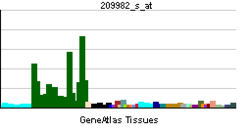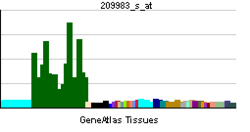- NRXN2
-
Neurexin 2 Identifiers Symbols NRXN2; FLJ40892; KIAA0921 External IDs OMIM: 600566 MGI: 1096362 HomoloGene: 86984 GeneCards: NRXN2 Gene Gene Ontology Molecular function • metal ion binding Cellular component • membrane
• integral to membraneBiological process • cell adhesion Sources: Amigo / QuickGO RNA expression pattern 

More reference expression data Orthologs Species Human Mouse Entrez 9379 18190 Ensembl ENSG00000110076 ENSMUSG00000033768 UniProt Q9P2S2 n/a RefSeq (mRNA) NM_015080.3 XM_489806 RefSeq (protein) NP_055895.1 XP_489806 Location (UCSC) Chr 11:
64.37 – 64.49 MbChr 19:
6.42 – 6.54 MbPubMed search [1] [2] Neurexin-2-alpha is a protein that in humans is encoded by the NRXN2 gene.[1][2]
Neurexins are a family of proteins that function in the vertebrate nervous system as cell adhesion molecules and receptors. They are encoded by several unlinked genes of which two, NRXN1 and NRXN3, are among the largest known human genes. Three of the genes (NRXN1-3) utilize two alternate promoters and include numerous alternatively spliced exons to generate thousands of distinct mRNA transcripts and protein isoforms. The majority of transcripts are produced from the upstream promoter and encode alpha-neurexin isoforms; a much smaller number of transcripts are produced from the downstream promoter and encode beta-neurexin isoforms. The alpha-neurexins contain epidermal growth factor-like (EGF-like) sequences and laminin G domains, and have been shown to interact with neurexophilins. The beta-neurexins lack EGF-like sequences and contain fewer laminin G domains than alpha-neurexins.[2]
References
- ^ Ushkaryov YA, Petrenko AG, Geppert M, Sudhof TC (Aug 1992). "Neurexins: synaptic cell surface proteins related to the alpha-latrotoxin receptor and laminin". Science 257 (5066): 50–56. doi:10.1126/science.1621094. PMID 1621094.
- ^ a b "Entrez Gene: NRXN2 neurexin 2". http://www.ncbi.nlm.nih.gov/sites/entrez?Db=gene&Cmd=ShowDetailView&TermToSearch=9379.
Further reading
- Nakajima D, Okazaki N, Yamakawa H et al. (2003). "Construction of expression-ready cDNA clones for KIAA genes: manual curation of 330 KIAA cDNA clones". DNA Res. 9 (3): 99–106. doi:10.1093/dnares/9.3.99. PMID 12168954.
- Ichtchenko K, Nguyen T, Südhof TC (1996). "Structures, alternative splicing, and neurexin binding of multiple neuroligins". J. Biol. Chem. 271 (5): 2676–2682. doi:10.1074/jbc.271.5.2676. PMID 8576240.
- Hata Y, Butz S, Südhof TC (1996). "CASK: a novel dlg/PSD95 homolog with an N-terminal calmodulin-dependent protein kinase domain identified by interaction with neurexins". J. Neurosci. 16 (8): 2488–94. PMID 8786425.
- Kurschner C, Mermelstein PG, Holden WT, Surmeier DJ (1998). "CIPP, a novel multivalent PDZ domain protein, selectively interacts with Kir4.0 family members, NMDA receptor subunits, neurexins, and neuroligins". Mol. Cell. Neurosci. 11 (3): 161–172. doi:10.1006/mcne.1998.0679. PMID 9647694.
- Hock B, Böhme B, Karn T et al. (1998). "PDZ-domain-mediated interaction of the Eph-related receptor tyrosine kinase EphB3 and the ras-binding protein AF6 depends on the kinase activity of the receptor". Proc. Natl. Acad. Sci. U.S.A. 95 (17): 9779–9784. doi:10.1073/pnas.95.17.9779. PMC 21413. PMID 9707552. http://www.pubmedcentral.nih.gov/articlerender.fcgi?tool=pmcentrez&artid=21413.
- Bergman L, Silins G, Grimmond S et al. (1999). "A 500-kb sequence-ready cosmid contig and transcript map of the MEN1 region on 11q13". Genomics 55 (1): 49–56. doi:10.1006/geno.1998.5625. PMID 9888998.
- Nagase T, Ishikawa K, Suyama M et al. (1999). "Prediction of the coding sequences of unidentified human genes. XIII. The complete sequences of 100 new cDNA clones from brain which code for large proteins in vitro". DNA Res. 6 (1): 63–70. doi:10.1093/dnares/6.1.63. PMID 10231032.
- Rowen L, Young J, Birditt B et al. (2002). "Analysis of the human neurexin genes: alternative splicing and the generation of protein diversity". Genomics 79 (4): 587–597. doi:10.1006/geno.2002.6734. PMID 11944992.
- Tabuchi K, Südhof TC (2002). "Structure and evolution of neurexin genes: insight into the mechanism of alternative splicing". Genomics 79 (6): 849–859. doi:10.1006/geno.2002.6780. PMID 12036300.
- Nakayama M, Kikuno R, Ohara O (2003). "Protein-protein interactions between large proteins: two-hybrid screening using a functionally classified library composed of long cDNAs". Genome Res. 12 (11): 1773–1784. doi:10.1101/gr.406902. PMC 187542. PMID 12421765. http://www.pubmedcentral.nih.gov/articlerender.fcgi?tool=pmcentrez&artid=187542.
- Ota T, Suzuki Y, Nishikawa T et al. (2004). "Complete sequencing and characterization of 21,243 full-length human cDNAs". Nat. Genet. 36 (1): 40–45. doi:10.1038/ng1285. PMID 14702039.
- Homma K, Kikuno RF, Nagase T et al. (2004). "Alternative splice variants encoding unstable protein domains exist in the human brain". J. Mol. Biol. 343 (5): 1207–1220. doi:10.1016/j.jmb.2004.09.028. PMID 15491607.
- Taylor TD, Noguchi H, Totoki Y et al. (2006). "Human chromosome 11 DNA sequence and analysis including novel gene identification". Nature 440 (7083): 497–500. doi:10.1038/nature04632. PMID 16554811.
Categories:- Human proteins
- Chromosome 11 gene stubs
Wikimedia Foundation. 2010.
